Report on Unit 508: Working in Teams, Leadership and Motivation
VerifiedAdded on 2021/04/14
|19
|4410
|26
Report
AI Summary
This report provides a detailed analysis of the key aspects of working in teams, leadership, and motivation. It begins by defining the qualities of an effective team and explores different team styles, such as functional and self-managed teams. The report then delves into the roles and skills of an ideal team leader, examining various leadership styles including strategic and autocratic approaches. Major theories of motivation, including Maslow's hierarchy of needs and Vroom's expectancy theory, are discussed, along with factors that motivate and demotivate individuals in the workplace. The report also covers delegation, distinguishing it from abdication, and explores its benefits and risks. Furthermore, it examines influencing skills, negotiation processes, and the importance of interpersonal relationships. Finally, it addresses conflict management, outlining common causes of disagreement and approaches to resolving conflicts within a team setting. The document is a student submission and is available on Desklib.
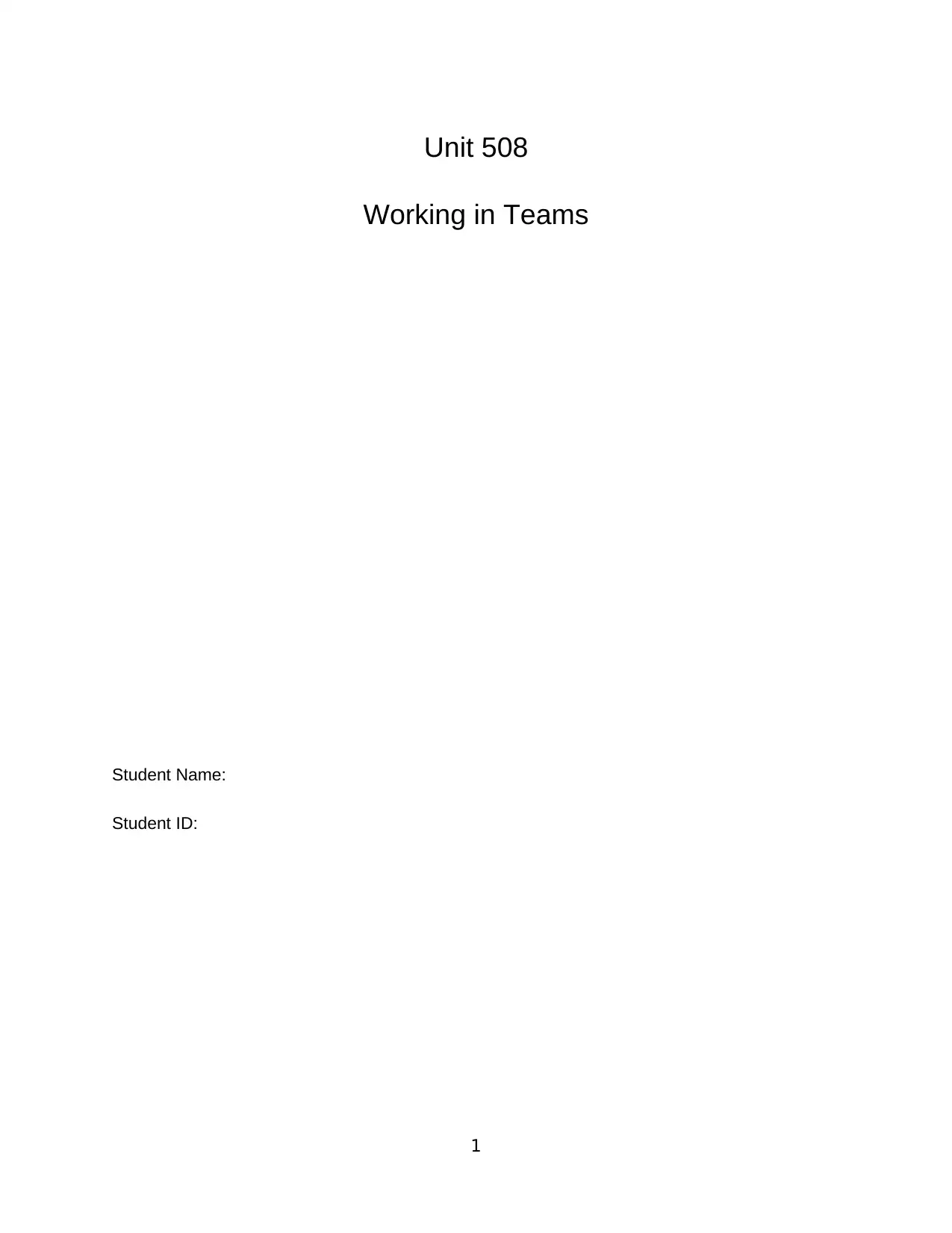
Unit 508
Working in Teams
Student Name:
Student ID:
1
Working in Teams
Student Name:
Student ID:
1
Paraphrase This Document
Need a fresh take? Get an instant paraphrase of this document with our AI Paraphraser

Table of Contents
Introduction................................................................................................................... 3
Task 1.......................................................................................................................... 4
Definition and description of the qualities which makes effective team................................4
Different styles of teams.............................................................................................. 4
Task 2.......................................................................................................................... 5
The roles and skills of being ideal team leader................................................................5
Different leadership style............................................................................................. 6
Task 3.......................................................................................................................... 8
Major theories of Motivation......................................................................................... 9
Key factors related with motivating and demotivating individual in the working environment.. .9
Task 4........................................................................................................................ 12
Definition of delegation and the difference between delegation and abdication of
responsibility............................................................................................................ 12
Benefits and Risks of delegation for the manager and the team.......................................13
Task 5........................................................................................................................ 14
Explaining what are the influencing skill and also how it operates in the working life...........14
Actions or behaviour which are needed to influencing others...........................................14
The process of negotiation......................................................................................... 15
Task 6........................................................................................................................ 15
The importance of creating good interpersonal relationships at work................................15
Differences between positive, negative and constructive feedback...................................16
Common causes and indications of disagreement while working in team..........................16
Approaches towards conflict management....................................................................17
Conclusion.................................................................................................................. 18
References................................................................................................................. 19
2
Introduction................................................................................................................... 3
Task 1.......................................................................................................................... 4
Definition and description of the qualities which makes effective team................................4
Different styles of teams.............................................................................................. 4
Task 2.......................................................................................................................... 5
The roles and skills of being ideal team leader................................................................5
Different leadership style............................................................................................. 6
Task 3.......................................................................................................................... 8
Major theories of Motivation......................................................................................... 9
Key factors related with motivating and demotivating individual in the working environment.. .9
Task 4........................................................................................................................ 12
Definition of delegation and the difference between delegation and abdication of
responsibility............................................................................................................ 12
Benefits and Risks of delegation for the manager and the team.......................................13
Task 5........................................................................................................................ 14
Explaining what are the influencing skill and also how it operates in the working life...........14
Actions or behaviour which are needed to influencing others...........................................14
The process of negotiation......................................................................................... 15
Task 6........................................................................................................................ 15
The importance of creating good interpersonal relationships at work................................15
Differences between positive, negative and constructive feedback...................................16
Common causes and indications of disagreement while working in team..........................16
Approaches towards conflict management....................................................................17
Conclusion.................................................................................................................. 18
References................................................................................................................. 19
2

Introduction
Working in team with diverse range of people indicates that the members of the team are being
synergized by working and sticking together for achieving organisational goals. Working in team
in the business organisation is an important factor as working together to accomplishing a goal
means that achieving organisational goals for the business company. There are some attributes
which indicates that the team is effective and on the other hand some indicates that team is not
effective. An attribute of effective can be having good communication among the team members
so that have better understanding with each other. To be an effective team the utmost thing that
is needed is having leader who can be considered as the one who will lead the team effectively.
3
Working in team with diverse range of people indicates that the members of the team are being
synergized by working and sticking together for achieving organisational goals. Working in team
in the business organisation is an important factor as working together to accomplishing a goal
means that achieving organisational goals for the business company. There are some attributes
which indicates that the team is effective and on the other hand some indicates that team is not
effective. An attribute of effective can be having good communication among the team members
so that have better understanding with each other. To be an effective team the utmost thing that
is needed is having leader who can be considered as the one who will lead the team effectively.
3
⊘ This is a preview!⊘
Do you want full access?
Subscribe today to unlock all pages.

Trusted by 1+ million students worldwide

Task 1
Definition and description of the qualities which makes effective team.
Effective Team
When a group of people works together with having the aim of achieving specific goals,
objectives or vision is called team. But not every team is called effective team as to be called an
effective the thing that is important is sharing same sort of goals with the help of their own skills
and knowledge sharing their knowledge with each other which will lead to have achieving one
specific organisational goals (BARRACLOUGH, 2016). With having effective team, the team
members need to have mutual understanding as well as respecting behaviour towards each
other. The qualities which makes a team an effective are providing below:
Being organised: One the most important quality that to be an effective team should have
been that the structure of the team needs to be good in manner. The task or work will be
effectively divided to the members of the team so that the workflow will be organised. Being
organisation will make impact on the performance of the organisation.
Effective communication: Another important element which is essential for being effective
team is that having the good communication process and this system should be spread
throughout the whole team and the performance of the team (Satinoff and Teitelbaum, 2013). If
in the team performance process of the team will not have effective communication then there
will be misunderstanding between employees or team members.
Different styles of teams.
In the business organisation with having one specific team will not be enough to meeting the
needs of the customers and also to achieve the organisational goals (Burns, 2012). Which is
why large organisation such as Apple will have different types of team in its organisational
environment and those styles are providing below:
Functional team: When the team is being formed with the help of functional people of the
organisation and the members of the team will be from same function. The functional team is
more type of common team which can be seen in every organisation. Functional team can be
including marketing team, finance team, management team and these are considered as
4
Definition and description of the qualities which makes effective team.
Effective Team
When a group of people works together with having the aim of achieving specific goals,
objectives or vision is called team. But not every team is called effective team as to be called an
effective the thing that is important is sharing same sort of goals with the help of their own skills
and knowledge sharing their knowledge with each other which will lead to have achieving one
specific organisational goals (BARRACLOUGH, 2016). With having effective team, the team
members need to have mutual understanding as well as respecting behaviour towards each
other. The qualities which makes a team an effective are providing below:
Being organised: One the most important quality that to be an effective team should have
been that the structure of the team needs to be good in manner. The task or work will be
effectively divided to the members of the team so that the workflow will be organised. Being
organisation will make impact on the performance of the organisation.
Effective communication: Another important element which is essential for being effective
team is that having the good communication process and this system should be spread
throughout the whole team and the performance of the team (Satinoff and Teitelbaum, 2013). If
in the team performance process of the team will not have effective communication then there
will be misunderstanding between employees or team members.
Different styles of teams.
In the business organisation with having one specific team will not be enough to meeting the
needs of the customers and also to achieve the organisational goals (Burns, 2012). Which is
why large organisation such as Apple will have different types of team in its organisational
environment and those styles are providing below:
Functional team: When the team is being formed with the help of functional people of the
organisation and the members of the team will be from same function. The functional team is
more type of common team which can be seen in every organisation. Functional team can be
including marketing team, finance team, management team and these are considered as
4
Paraphrase This Document
Need a fresh take? Get an instant paraphrase of this document with our AI Paraphraser
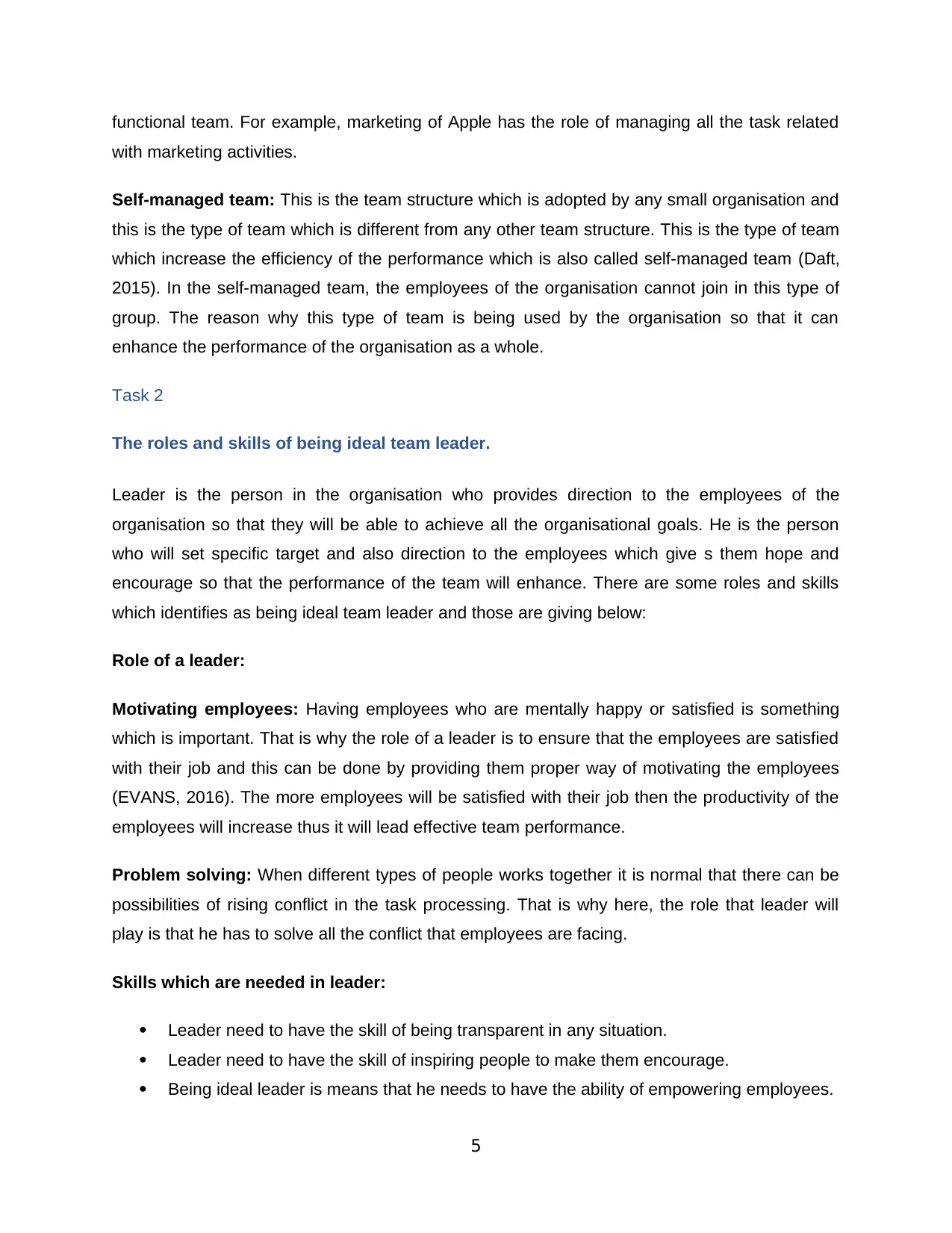
functional team. For example, marketing of Apple has the role of managing all the task related
with marketing activities.
Self-managed team: This is the team structure which is adopted by any small organisation and
this is the type of team which is different from any other team structure. This is the type of team
which increase the efficiency of the performance which is also called self-managed team (Daft,
2015). In the self-managed team, the employees of the organisation cannot join in this type of
group. The reason why this type of team is being used by the organisation so that it can
enhance the performance of the organisation as a whole.
Task 2
The roles and skills of being ideal team leader.
Leader is the person in the organisation who provides direction to the employees of the
organisation so that they will be able to achieve all the organisational goals. He is the person
who will set specific target and also direction to the employees which give s them hope and
encourage so that the performance of the team will enhance. There are some roles and skills
which identifies as being ideal team leader and those are giving below:
Role of a leader:
Motivating employees: Having employees who are mentally happy or satisfied is something
which is important. That is why the role of a leader is to ensure that the employees are satisfied
with their job and this can be done by providing them proper way of motivating the employees
(EVANS, 2016). The more employees will be satisfied with their job then the productivity of the
employees will increase thus it will lead effective team performance.
Problem solving: When different types of people works together it is normal that there can be
possibilities of rising conflict in the task processing. That is why here, the role that leader will
play is that he has to solve all the conflict that employees are facing.
Skills which are needed in leader:
Leader need to have the skill of being transparent in any situation.
Leader need to have the skill of inspiring people to make them encourage.
Being ideal leader is means that he needs to have the ability of empowering employees.
5
with marketing activities.
Self-managed team: This is the team structure which is adopted by any small organisation and
this is the type of team which is different from any other team structure. This is the type of team
which increase the efficiency of the performance which is also called self-managed team (Daft,
2015). In the self-managed team, the employees of the organisation cannot join in this type of
group. The reason why this type of team is being used by the organisation so that it can
enhance the performance of the organisation as a whole.
Task 2
The roles and skills of being ideal team leader.
Leader is the person in the organisation who provides direction to the employees of the
organisation so that they will be able to achieve all the organisational goals. He is the person
who will set specific target and also direction to the employees which give s them hope and
encourage so that the performance of the team will enhance. There are some roles and skills
which identifies as being ideal team leader and those are giving below:
Role of a leader:
Motivating employees: Having employees who are mentally happy or satisfied is something
which is important. That is why the role of a leader is to ensure that the employees are satisfied
with their job and this can be done by providing them proper way of motivating the employees
(EVANS, 2016). The more employees will be satisfied with their job then the productivity of the
employees will increase thus it will lead effective team performance.
Problem solving: When different types of people works together it is normal that there can be
possibilities of rising conflict in the task processing. That is why here, the role that leader will
play is that he has to solve all the conflict that employees are facing.
Skills which are needed in leader:
Leader need to have the skill of being transparent in any situation.
Leader need to have the skill of inspiring people to make them encourage.
Being ideal leader is means that he needs to have the ability of empowering employees.
5
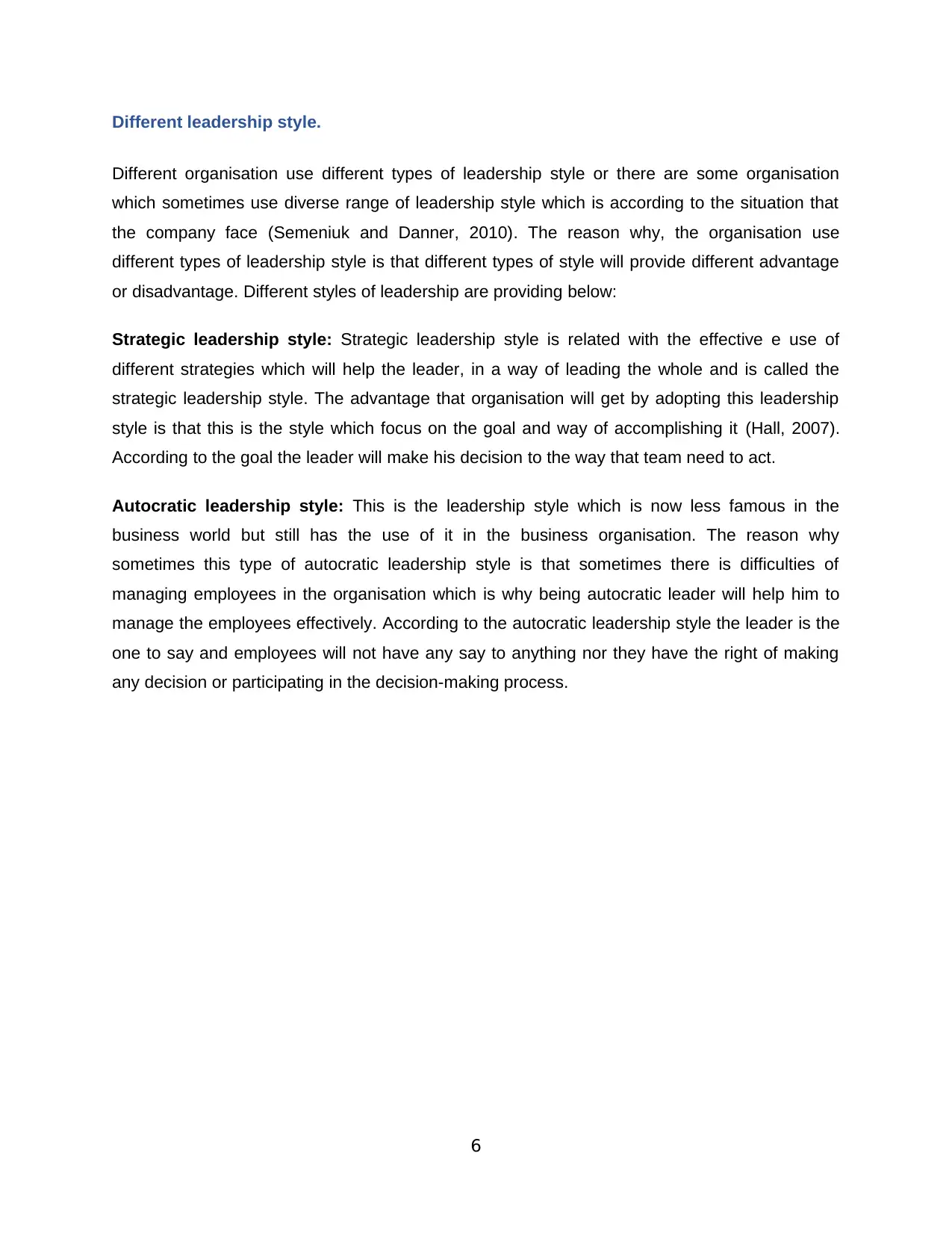
Different leadership style.
Different organisation use different types of leadership style or there are some organisation
which sometimes use diverse range of leadership style which is according to the situation that
the company face (Semeniuk and Danner, 2010). The reason why, the organisation use
different types of leadership style is that different types of style will provide different advantage
or disadvantage. Different styles of leadership are providing below:
Strategic leadership style: Strategic leadership style is related with the effective e use of
different strategies which will help the leader, in a way of leading the whole and is called the
strategic leadership style. The advantage that organisation will get by adopting this leadership
style is that this is the style which focus on the goal and way of accomplishing it (Hall, 2007).
According to the goal the leader will make his decision to the way that team need to act.
Autocratic leadership style: This is the leadership style which is now less famous in the
business world but still has the use of it in the business organisation. The reason why
sometimes this type of autocratic leadership style is that sometimes there is difficulties of
managing employees in the organisation which is why being autocratic leader will help him to
manage the employees effectively. According to the autocratic leadership style the leader is the
one to say and employees will not have any say to anything nor they have the right of making
any decision or participating in the decision-making process.
6
Different organisation use different types of leadership style or there are some organisation
which sometimes use diverse range of leadership style which is according to the situation that
the company face (Semeniuk and Danner, 2010). The reason why, the organisation use
different types of leadership style is that different types of style will provide different advantage
or disadvantage. Different styles of leadership are providing below:
Strategic leadership style: Strategic leadership style is related with the effective e use of
different strategies which will help the leader, in a way of leading the whole and is called the
strategic leadership style. The advantage that organisation will get by adopting this leadership
style is that this is the style which focus on the goal and way of accomplishing it (Hall, 2007).
According to the goal the leader will make his decision to the way that team need to act.
Autocratic leadership style: This is the leadership style which is now less famous in the
business world but still has the use of it in the business organisation. The reason why
sometimes this type of autocratic leadership style is that sometimes there is difficulties of
managing employees in the organisation which is why being autocratic leader will help him to
manage the employees effectively. According to the autocratic leadership style the leader is the
one to say and employees will not have any say to anything nor they have the right of making
any decision or participating in the decision-making process.
6
⊘ This is a preview!⊘
Do you want full access?
Subscribe today to unlock all pages.

Trusted by 1+ million students worldwide

7
Paraphrase This Document
Need a fresh take? Get an instant paraphrase of this document with our AI Paraphraser
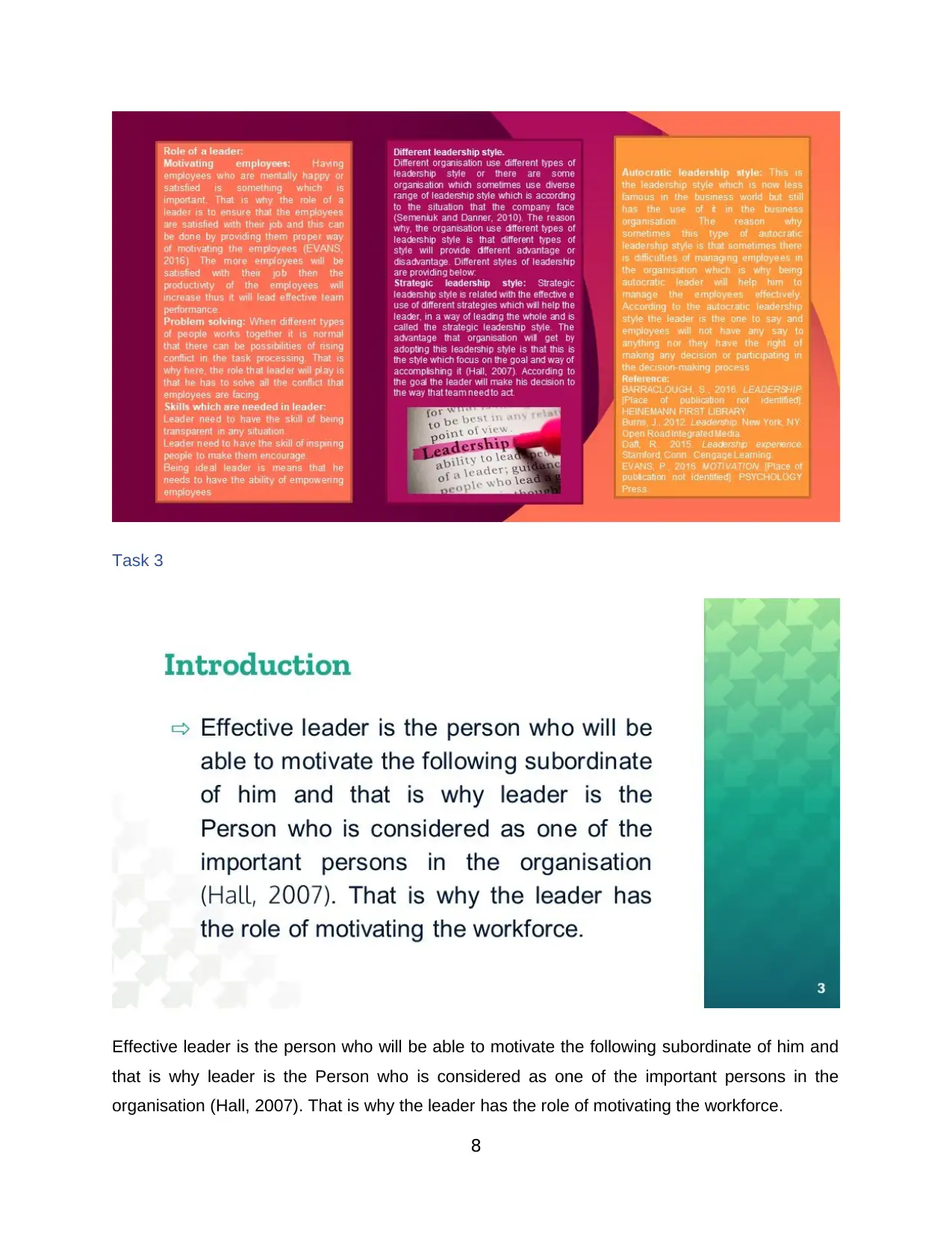
Task 3
Effective leader is the person who will be able to motivate the following subordinate of him and
that is why leader is the Person who is considered as one of the important persons in the
organisation (Hall, 2007). That is why the leader has the role of motivating the workforce.
8
Effective leader is the person who will be able to motivate the following subordinate of him and
that is why leader is the Person who is considered as one of the important persons in the
organisation (Hall, 2007). That is why the leader has the role of motivating the workforce.
8
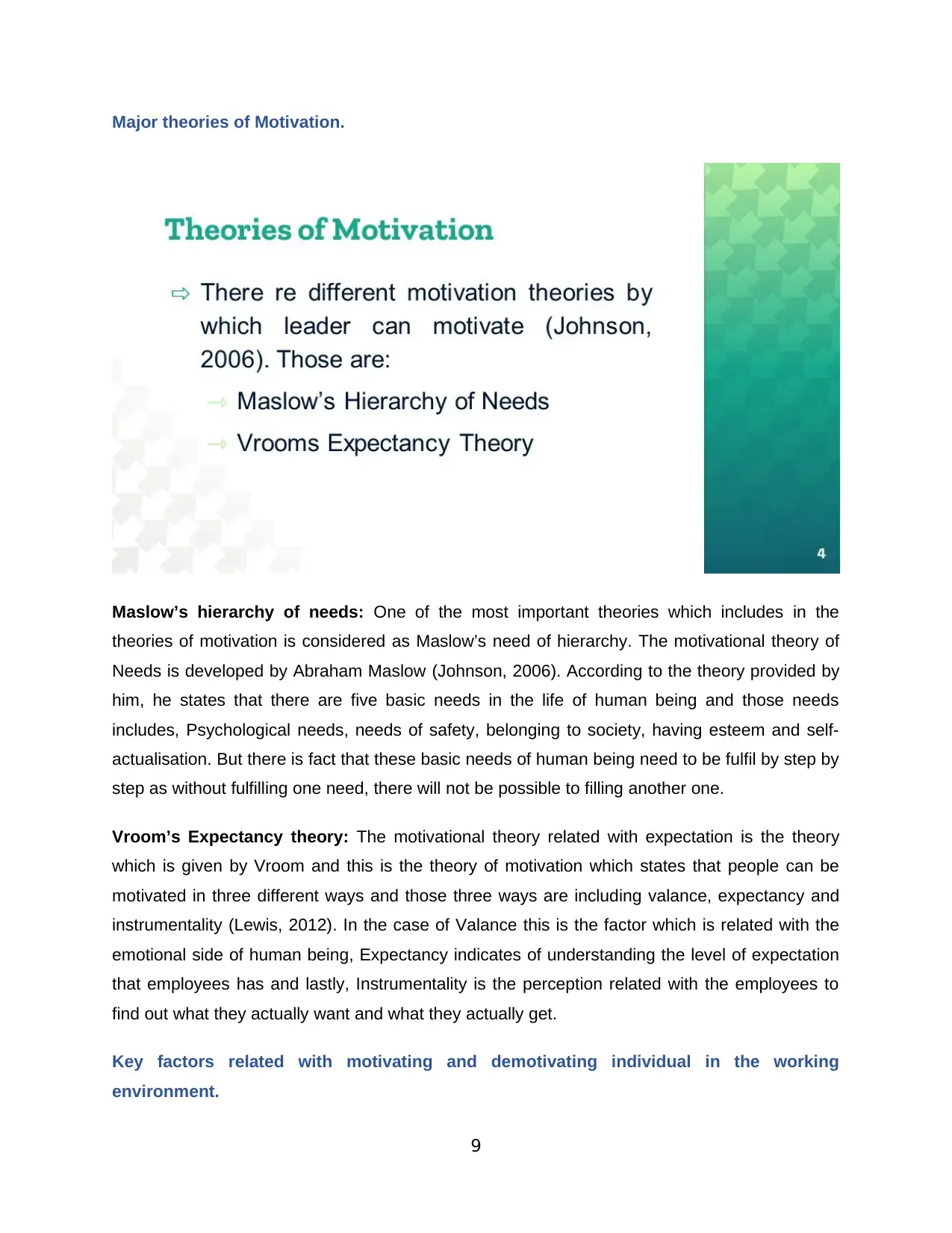
Major theories of Motivation.
Maslow’s hierarchy of needs: One of the most important theories which includes in the
theories of motivation is considered as Maslow’s need of hierarchy. The motivational theory of
Needs is developed by Abraham Maslow (Johnson, 2006). According to the theory provided by
him, he states that there are five basic needs in the life of human being and those needs
includes, Psychological needs, needs of safety, belonging to society, having esteem and self-
actualisation. But there is fact that these basic needs of human being need to be fulfil by step by
step as without fulfilling one need, there will not be possible to filling another one.
Vroom’s Expectancy theory: The motivational theory related with expectation is the theory
which is given by Vroom and this is the theory of motivation which states that people can be
motivated in three different ways and those three ways are including valance, expectancy and
instrumentality (Lewis, 2012). In the case of Valance this is the factor which is related with the
emotional side of human being, Expectancy indicates of understanding the level of expectation
that employees has and lastly, Instrumentality is the perception related with the employees to
find out what they actually want and what they actually get.
Key factors related with motivating and demotivating individual in the working
environment.
9
Maslow’s hierarchy of needs: One of the most important theories which includes in the
theories of motivation is considered as Maslow’s need of hierarchy. The motivational theory of
Needs is developed by Abraham Maslow (Johnson, 2006). According to the theory provided by
him, he states that there are five basic needs in the life of human being and those needs
includes, Psychological needs, needs of safety, belonging to society, having esteem and self-
actualisation. But there is fact that these basic needs of human being need to be fulfil by step by
step as without fulfilling one need, there will not be possible to filling another one.
Vroom’s Expectancy theory: The motivational theory related with expectation is the theory
which is given by Vroom and this is the theory of motivation which states that people can be
motivated in three different ways and those three ways are including valance, expectancy and
instrumentality (Lewis, 2012). In the case of Valance this is the factor which is related with the
emotional side of human being, Expectancy indicates of understanding the level of expectation
that employees has and lastly, Instrumentality is the perception related with the employees to
find out what they actually want and what they actually get.
Key factors related with motivating and demotivating individual in the working
environment.
9
⊘ This is a preview!⊘
Do you want full access?
Subscribe today to unlock all pages.

Trusted by 1+ million students worldwide

The nature of effective leader means that he has the knowledge regarding which factors work
as encouragement for the employees and which factors works as dissatisfactory impact on the
performance of the employees. That is why to have better understanding both motivational and
demotivational factors provided below:
Factors of motivation:
Job Compensation: There can be two way of motivating other and one of them is motivating
with tangible thing and in the case of tangible thing can be considered as the job compensation
that is get by the employees (Safire and Safir, 2000). Providing job compensation in right time
by following commitment of giving job compensation will bring job satisfaction of the employees.
Non-monetary benefits: The other way that organisation will be able to motivate the
employees of the company is that providing intangible benefits to the employees. Intangible
benefits can be also term as non-monetary benefits. There are diverse range of intangible
motivation such as providing medical facilities to the employees or providing break-time room so
that employee has the scope relaxing.
Factors of demotivation:
10
as encouragement for the employees and which factors works as dissatisfactory impact on the
performance of the employees. That is why to have better understanding both motivational and
demotivational factors provided below:
Factors of motivation:
Job Compensation: There can be two way of motivating other and one of them is motivating
with tangible thing and in the case of tangible thing can be considered as the job compensation
that is get by the employees (Safire and Safir, 2000). Providing job compensation in right time
by following commitment of giving job compensation will bring job satisfaction of the employees.
Non-monetary benefits: The other way that organisation will be able to motivate the
employees of the company is that providing intangible benefits to the employees. Intangible
benefits can be also term as non-monetary benefits. There are diverse range of intangible
motivation such as providing medical facilities to the employees or providing break-time room so
that employee has the scope relaxing.
Factors of demotivation:
10
Paraphrase This Document
Need a fresh take? Get an instant paraphrase of this document with our AI Paraphraser

Doing nepotism: Everyone in the business organisation has the right of treating as equal as
other employees of the company. Which is why if the leader or manager of the company
provides extra care to any individual of the organisation then it will be injustice to others. Which
is why doing nepotism will bring demotivation to the employee’s behaviour.
Job security: One of the most demotivational factors can be include is not providing the feeling
of job security to the employees. If the employee’s feel that the job he is doing is not permanent
and he might fire from his post then he will not get any motivation for doing his work
(Organisation for Economic Co-operation and Development, 2007). Which is why not providing
job security is one of the factors which can be considered as demotivating factors.
11
other employees of the company. Which is why if the leader or manager of the company
provides extra care to any individual of the organisation then it will be injustice to others. Which
is why doing nepotism will bring demotivation to the employee’s behaviour.
Job security: One of the most demotivational factors can be include is not providing the feeling
of job security to the employees. If the employee’s feel that the job he is doing is not permanent
and he might fire from his post then he will not get any motivation for doing his work
(Organisation for Economic Co-operation and Development, 2007). Which is why not providing
job security is one of the factors which can be considered as demotivating factors.
11
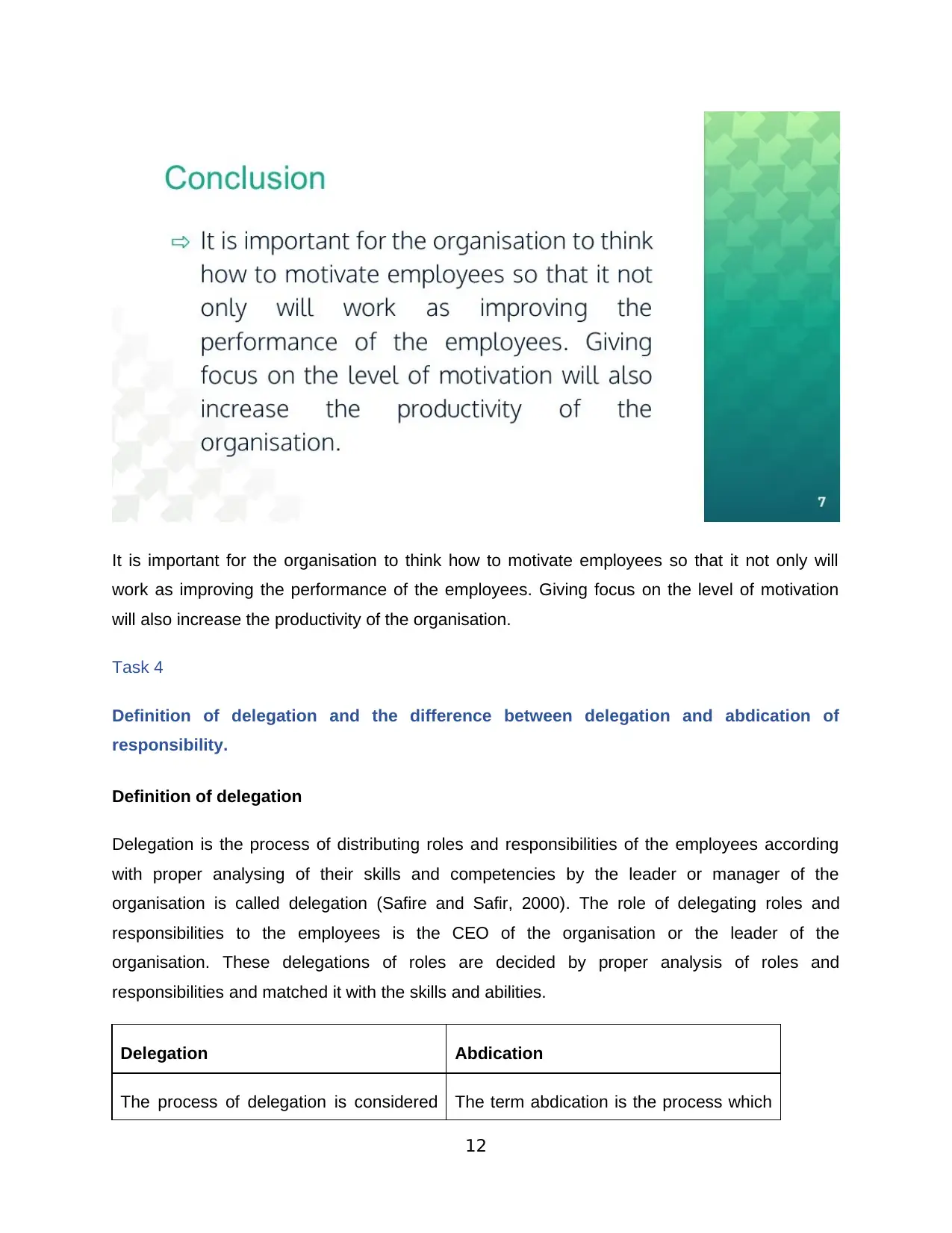
It is important for the organisation to think how to motivate employees so that it not only will
work as improving the performance of the employees. Giving focus on the level of motivation
will also increase the productivity of the organisation.
Task 4
Definition of delegation and the difference between delegation and abdication of
responsibility.
Definition of delegation
Delegation is the process of distributing roles and responsibilities of the employees according
with proper analysing of their skills and competencies by the leader or manager of the
organisation is called delegation (Safire and Safir, 2000). The role of delegating roles and
responsibilities to the employees is the CEO of the organisation or the leader of the
organisation. These delegations of roles are decided by proper analysis of roles and
responsibilities and matched it with the skills and abilities.
Delegation Abdication
The process of delegation is considered The term abdication is the process which
12
work as improving the performance of the employees. Giving focus on the level of motivation
will also increase the productivity of the organisation.
Task 4
Definition of delegation and the difference between delegation and abdication of
responsibility.
Definition of delegation
Delegation is the process of distributing roles and responsibilities of the employees according
with proper analysing of their skills and competencies by the leader or manager of the
organisation is called delegation (Safire and Safir, 2000). The role of delegating roles and
responsibilities to the employees is the CEO of the organisation or the leader of the
organisation. These delegations of roles are decided by proper analysis of roles and
responsibilities and matched it with the skills and abilities.
Delegation Abdication
The process of delegation is considered The term abdication is the process which
12
⊘ This is a preview!⊘
Do you want full access?
Subscribe today to unlock all pages.

Trusted by 1+ million students worldwide
1 out of 19
Related Documents
Your All-in-One AI-Powered Toolkit for Academic Success.
+13062052269
info@desklib.com
Available 24*7 on WhatsApp / Email
![[object Object]](/_next/static/media/star-bottom.7253800d.svg)
Unlock your academic potential
Copyright © 2020–2025 A2Z Services. All Rights Reserved. Developed and managed by ZUCOL.





